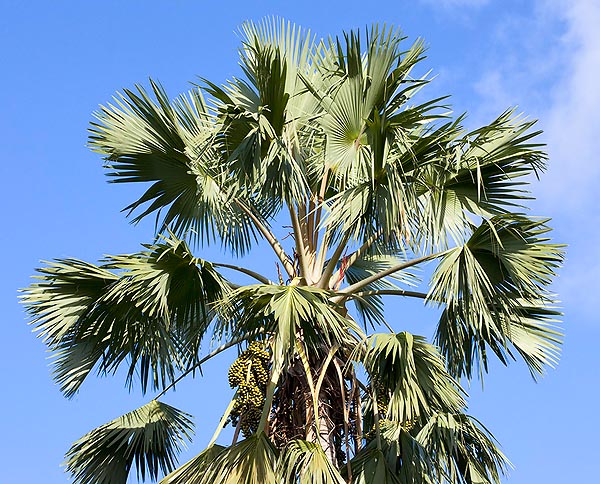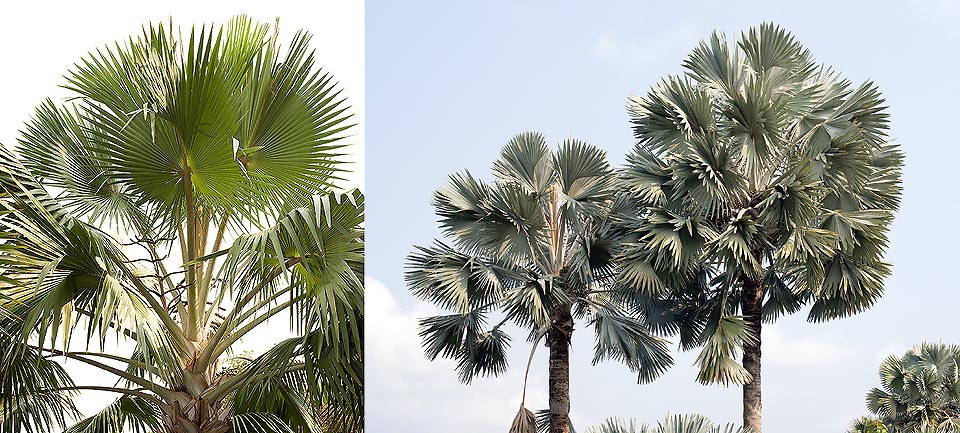Family : Arecaceae

Text © Pietro Puccio

English translation by Mario Beltramini

Imposing palm, with 40 cm trunk and 20 m tall. Fast growth in the Tropics © Giuseppe Mazza
Native to Madagascar, it grows in the savannahs of the western coast of the island, where it is one of the few perennial species and with high trunk resisting to the periodical fires of anthropic origin.
The genus is honoured to the German chancellor Otto von Bismarck (1815-1898), the Latin name of the species “nobilis” = magnificent, noble, is surely appropriate for this species as it is one of the most imposing and ornamental of the family of the palms.
Common names: satra, satrabe, satrana, satranabe (Malagasy); Bismarck palm (English); palmier de Bismarck (French); palmeira-de-Bismarck (Portuguese); palmera de Bismarck (Spanish); Bismarckpalme, Bismarck-Palme (German).
Bismarckia nobilis Hildebrandt & H. Wendl. (1881) is a dioecious (each individual carries either only male flowers or female ones) species, with solitary trunk, imposing, up to 20 m and more tall, and with diameter of about 40 cm in the median part, up to 80 cm at the base, covered by the remnants of the foliar bases in the young plants, of brown-greyish colour and marked by the close rings of the scars of the foliar bases and by thick vertical fissures in the adult plants. The leaves are costapalmate, almost circular, broad up to more than 2 m, waxy, of grey to grey-blue colour with 50-70 rigid segments, just bifid at the extremity, of which the most external ones are united at the base for about ¼ – ½ of their length, the innermost ones for about the 80%; the petiole, 1,5-2 m long and just indented at the borders, is covered by a white waxy film. There is also a variety with wholly green leaves.
The inflorescences, ramified, generate between the leaves, similar in the structure in the male and female plants, are formed by a main axis with lateral ramifications carrying, grouped at the apex, up to nine, in the male plants, floriferous branches 15-25 cm long of brown red colour, usually in lesser quantity in the female ones; the flowers are tiny and whitish.
The fruits are ovoid or globose, 3-6 cm long, of dark brown colour. It reproduces by seed which germinates in 1-2 months with bottom heat, even in more than one year if without same; the use of deep pots (25 cm at least) is advisable seen its germination characteristics.

Bismarckia nobilis even 2 m and more broad huge leaves are almost circular, costapalmate, waxy, grey, grey-blue or green © Giuseppe Mazza
Bismarckia nobilis was assessed in 2010 by The IUCN Red List of Threatened Species in the category of “LC, Least Concern”.
Palm of tremendous ornamental and landscape value due to the shape, size and colour of the leaves, it has had a remarkable diffusion during the last years in all the tropical and subtropical countries, it is to be utilized isolated or in groups, having care to leave an ample free space around in order to fully enhance its characteristics.
Of relatively fast growth, especially in full sun, it adapts to different types of soil, provided well draining, and can resist, when adult, to long drought periods, even if it takes advantage from regular waterings during the warmest months.
It has proven cultivable also in temperate climate zones with mild winters, when adult and in well drained and dry soils, it can resist to temperatures up to -3, -4 °C, for a short period, with limited damages to the foliage; the green leaves variety is less resistant to the low temperatures, getting damages already by around the 0 °C. It is little utilized as pot plant; due to its size it can be cultivated only in spacious locations which must be also extremely luminous. It is probably the most diffused palm in Madagascar; the trunks are utilized locally in the constructions and the leaves as covering of the dwellings.
Synonyms: Medemia nobilis (Hildebrandt & H. Wendl.) Gall. (1904).
→ For general notions about ARECACEAE please click here.
